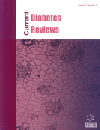- Home
- A-Z Publications
- Current Diabetes Reviews
- Previous Issues
- Volume 10, Issue 5, 2014
Current Diabetes Reviews - Volume 10, Issue 5, 2014
Volume 10, Issue 5, 2014
-
-
Social Media for Diabetes Health Education - Inclusive or Exclusive?
More LessBy B. Rani PalTechnological innovations are rising rapidly and are inevitably becoming part of the health care environment. Patients frequently access Social media as a forum for discussion of personal health issues; and healthcare providers are now considering ways of harnessing social media as a source of learning and teaching. This review highlights some of the complex issues of using social media as an opportunity for interactio Read More
-
-
-
The Bid to Lose Weight: Impact of Social Media on Weight Perceptions, Weight Control and Diabetes
More LessAuthors: Leah Das, Ranjini Mohan and Tafadzwa MakayaOver the last decade the internet has come to permeate every aspect of our lives. With huge leaps in accessibility of the internet via mobile personal devices such as smart cellular phones and tablets, individuals are connected to the internet virtually all the time. It is no surprise therefore that social media now dominates the lives of many people within society. The authors take a look at how social media is influencing diab Read More
-
-
-
Self-management of Diabetes in Children and Young Adults Using Technology and Smartphone Applications
More LessAuthors: Siobhan Sheehy, Georgia Cohen and Katharine R. OwenTreatment compliance and adherence are often a challenge in patients with type 1 diabetes, particularly for adolescent and young adult patients. With the availability of the internet and smart phone applications (apps) there is a hope that such technology could provide a means to encourage treatment adherence in this group of patients. This review focuses on whether telemedicine and smartphone technology in diabetes can Read More
-
-
-
Glucagon-Like Peptide 1 and the Cardiovascular System
More LessBy Stephen FavaGlucagon-like peptide 1 (GLP1) is a major incretin hormone. This means that it is secreted by the gut in response to food and helps in reducing post-prandial glucose exertion. It achieves this through a number of mechanisms, including stimulating insulin release by pancreatic β-cells in a glucose-dependent manner; inhibition of glucagon release by pancreatic α-cells (also in a glucose-dependent manner); induction of central appe Read More
-
-
-
Glucose Tolerance: Hypothesis Testing on Malaysian Diabetic Community
More LessOur study objective was to evaluate glucose tolerance and effecting factors among diabetes patients’ with home care program (PHCP) in Malaysian community. A 24-week longitudinal quasi-experimental -single blind - pre/post-test study design was used to assess the effectiveness of a diabetes education program to enhance self-care practices. An attrition rate of 25% implied longitudinal design of the study in the calculation of s Read More
-
-
-
Physiological Mechanisms of Action of Incretin and Insulin in Regulating Skeletal Muscle Metabolism
More LessType II diabetes (T2D) is a progressive condition affecting approximately 350 million adults worldwide. Whilst skeletal muscle insulin resistance and beta-cell dysfunction are recognised causes of T2D, progressive loss of lean muscle mass (reducing surface area for glucose disposal area) in tandem with ageing-related adiposity (i.e. sarcopenic obesity) also plays an important role in driving hyperglycaemia progression. The a Read More
-
-
-
Evaluation Approach can Significantly Influence Oral Glucose-Lowering Drugs Total Mortality Risks in Retrospective Cohorts of Type 2 Diabetes Mellitus Patients
More LessAuthors: Mykolay Khalangot and Volodymir KovtunBackground: Retrospective evaluations of mortality risks in cohorts of patients with type 2 diabetes (T2D), receiving oral glucose-lowering drugs (OGLDs) gave conclusions about association between certain OGLDs and mortality that do not exactly agree with each other. Different approaches were used: recording the outcomes depending on the first prescription, later changes were ignored or receiving one of OGLDs accordin Read More
-
Volumes & issues
-
Volume 21 (2025)
-
Volume 20 (2024)
-
Volume 19 (2023)
-
Volume 18 (2022)
-
Volume 17 (2021)
-
Volume 16 (2020)
-
Volume 15 (2019)
-
Volume 14 (2018)
-
Volume 13 (2017)
-
Volume 12 (2016)
-
Volume 11 (2015)
-
Volume 10 (2014)
-
Volume 9 (2013)
-
Volume 8 (2012)
-
Volume 7 (2011)
-
Volume 6 (2010)
-
Volume 5 (2009)
-
Volume 4 (2008)
-
Volume 3 (2007)
-
Volume 2 (2006)
-
Volume 1 (2005)
Most Read This Month
Article
content/journals/cdr
Journal
10
5
false
en


